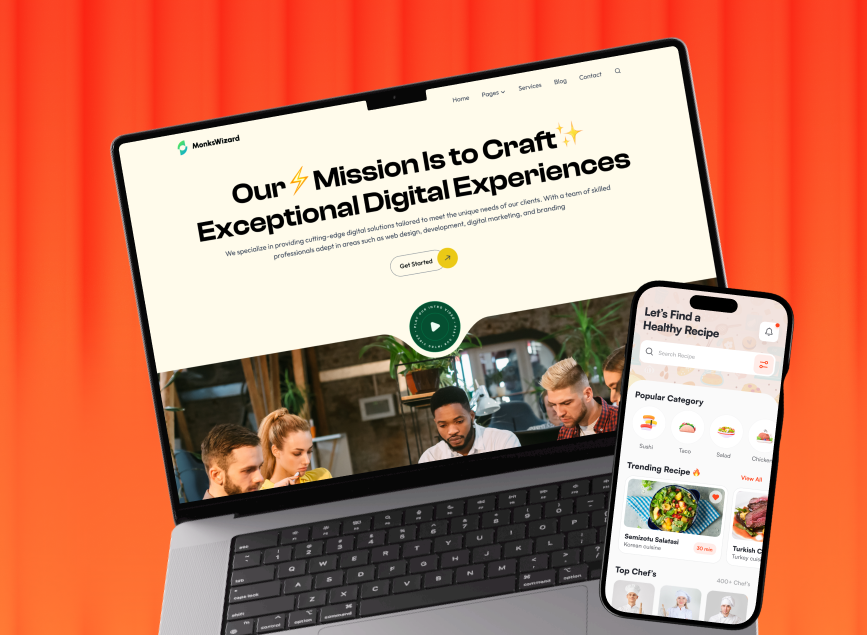
Key Takeaways
The Edtech industry is booming every day. It’s because digital learning tools have become an integral part of education nowadays. However, the success of these tools heavily relies on one key factor: User Experience (UX).
Good UX design in Edtech makes learning more engaging, accessible, and effective. When students find an app easy to use, they are more likely to stay motivated and learn better. Not just students, but teachers also benefit from intuitive interfaces that save them time and simplify their tasks.
UX in Edtech is not just about making things look nice; it’s about creating a smooth and supportive learning journey for users. That’s why novice UX designers should learn the UX best practices to improve their creativity for educational outcomes.
What Is Edtech?
Edtech is actually the short form of Educational Technology. This type of technology commonly uses different tools and applications to improve learning things. It can be online courses, educational apps, interactive whiteboards, and even classroom tablets.

Unlike the traditional educational system, which usually relies on schools, teachers, and physical classrooms, Edtech focuses on something more digitized. It utilizes digital solutions to make the educational system easier and more efficient.
For that, Edtech creates more engaging, personalized, and effective learning environments. It introduces different technical methods to meet the diverse needs of students. Also, it provides individualized learning experiences that suit different styles and paces.
That’s the reason this sector is crucial for students, teachers, and lifelong learners who need modern, flexible ways to learn and teach. This approach of Edtech simply supports better engagement and helps achieve more effective learning outcomes.
Why UX Matters in Edtech Products?
UX is a necessity, no matter what industry a product belongs to. For an Edtech app or website, UX is a must-have. These types of products need to keep users staying longer so that they can utilize the products to learn things. However, a UX helps Edtech products be effective. If I open it up a little, the following facts will be enough.

Make Learning Efficient for Users
Good UX design has a great impact and it makes learning efficient. When an app is easy to use, users can focus on their studies properly. They don’t have to spend time figuring out how to navigate the tool. Clear instructions, intuitive design, and simple navigation help them learn faster and more effectively.
Help Focusing on the Learning Ecosystem
A well-designed UX keeps the focus solely on the learning ecosystem. It ensures that the interface supports educational goals. For example, organizing content logically and providing helpful feedback keeps users engaged. It also helps them stay on track and complete their courses successfully.
Make the Product Accessible for All
You must agree that accessibility is the major aspect of UX, especially in Edtech. A good product should be usable by everyone. Eventually, it has to be accessible to people with disabilities.
A good UX ensures features like adjustable text sizes, screen readers, and high-contrast modes. As a result, all users have equal access to learning materials.
Helps Ensuring User Satisfaction
User satisfaction is essential for the success of any product, no matter what industry it belongs to. For an Edtech app, it’s even more essential as users tend to stay in the app longer to learn things.
However, when users have a positive experience, they are more likely to continue using the product and recommend it to others. And you know what, UX is the most impactful factor in ensuring user satisfaction.
Ensure Business Benefits for All Stakeholders
Good UX not just benefits users but also stakeholders. Satisfied users usually provide better reviews, higher retention rates, and more referrals. For businesses, this means a lot. These reviews and recommendations effectively increase revenue and growth. For educators, it means better teaching outcomes and more efficient use of resources.
As we see, UX matters in Edtech products because it makes learning efficient, keeps the focus on education, and ensures accessibility. Also, it enhances user satisfaction and brings business benefits. For UX designers, understanding these aspects is a must-have so that they can prioritize UX while designing Edtech properly.
UX Features of an Ideal Edtech App
An ideal Edtech app should provide a seamless and engaging user experience. It must incorporate with the following UX features:
- Intuitive Navigation: Easy-to-use interface with clear menus and buttons.
- Responsive Design: Consistent experience across all devices, including smartphones, tablets, and desktops.
- Personalization: Customize learning paths and content recommendations based on real user preferences.
- Engaging Content: Interactive elements like videos, quizzes, and gamified tasks to keep users motivated.
- Accessibility: Features like adjustable text sizes, screen readers, and high-contrast modes to accommodate all users.
- Feedback and Progress Tracking: Real-time feedback and progress indicators to help users stay on track.
- Collaboration Tools: Options for discussion forums, group projects, and peer reviews.
- Offline Access: Ability to download content for use without an internet connection.
- Support and Help: Easily accessible help resources, such as FAQs, tutorials, and customer support.
Examples of Ideal Edtech Apps
As you know, an ed-tech app can be from different categories. Let’s check out some of the world-class Edtech apps that come with nice UX designs:

Duolingo (Language Learning App)
Duolingo is a top-rated language-learning app that people around the world are using currently. It has been popular specifically for its gamified approach to education. Its UX is exceptional because of its interactive and user-friendly design.
Features like bite-sized lessons, progress tracking, and rewards simply make it a unique Edtech app with perfect UX. This engaging format keeps users motivated and coming back daily. That is why it has become popular worldwide for language learners who love a fun and efficient way to learn new languages.
Skillshare (Online Learning Platform)
Skillshare is an online learning platform that offers thousands of classes in different subjects. Its UX prioritizes an intuitive interface, easy navigation, and personalized recommendations.
Users appreciate the smooth video playback and interactive community features. This seamless experience enhances user engagement and retention. This way, Skillshare becomes a favorite for individuals looking to expand their skills through creative and professional courses.
Edmodo (Educational Collaboration Platform)
Edmodo is a digital classroom platform that simplifies collaboration between students, teachers, and parents. Its UX comes with a clean design, an easy-to-use interface, and strong communication tools.
Features like assignment management, quizzes, and real-time updates streamline classroom activities. This way, it connects users and ensures an efficient learning environment. This user-centric approach contributes to its widespread adoption in educational institutions.
Live Classes (Virtual Classroom Platform)
Live Classes offer real-time, interactive virtual classroom experiences. Their UX is superior because of high-quality video streaming, user-friendly interfaces, and seamless integration with educational tools.
Features like instant feedback, interactive whiteboards, and breakout rooms enhance the learning experience. These features make it even more engaging and effective. This exceptional UX helps Live Classes gain popularity among educators and learners overnight.
Oter (Micro Book Reading App)
Oter is a recently developed reading app that is supposed to be very famous shortly. It’s a micro book app that we designed for busy professionals who want to keep reading and personal development efficiently. It exemplifies an ideal Edtech app through its user-centric features, like

:
- Access a huge collection of book summaries on different topics, with options to request specific titles.
- Collection of numerous microbooks in both text and audio formats, perfect for on-the-go consumption.
- Let users highlight important text and save it for future reference to create a personalized library of insights.
- Offer book suggestions according to users’ interests based on your interactions with the app.
- Define reading goals and engage in challenges to help you achieve them.
- Oter Pro users receive credits each month that let them unlock multiple micro books.
If you want to learn more about the design process and features of Oter, check out the Oter case study.
8 Best UX Practices for Designing an Edtech Product
For UX designers, learning the best practices in Edtech UX is essential. It enhances their skills and contributes to the development of impactful educational tools. Check out the following tricks. These can make you work like a pro in the Edtech industry.
1. The Initial Priority Should Be Understanding Targeted Users
First, understand who your users are. Are they primary school students, college students, or adult learners? You can conduct surveys, interviews, and research to understand the targeted users.
You need to know their needs, preferences, and pain points properly. Proper knowledge of the targeted user helps you customize your product to meet their specific requirements easily. As a result, the product will be more effective and user-friendly.
2. Think Yourself As Targeted Users and Prioritize Your Needs
Again it’s about understanding the users. Even though surveys and interviews work better, nothing can beat putting yourself in your users’ shoes. You need to imagine yourself as a user who understands their daily challenges and what they need from an Edtech product.
In this case, it’s helpful to prioritize features that solve their problems and make learning easier. Leave the sources and think about what you personally expect from the app. This approach will help you make your product relevant and valuable to its users.
3. For Inspiration, Look Beyond the Specific Industry
Don’t limit yourself to looking at other Edtech products for inspiration. You have to explore apps and websites from different industries, like gaming, social media, and e-commerce. For instance, gamification elements from gaming can make learning more fun.

Nobody won’t tell you to follow a specific pattern to design an app or other digital product. So, you can get inspiration from any industry and product. Just make sure to be relevant while choosing elements.
4. Use More Visual Elements to Increase Visual Memory
People remember visual information better than text. And you have to utilize these metrics by using visuals so that they can help learn things in a better way.
It’s better to properly use icons, images, videos, and infographics to explain concepts and instructions. Visual elements make content more engaging and easier to understand, especially for younger users or those with limited reading skills. Well, be careful in this case, and don’t overwhelm it with so many icons and images.
5. Use More Personalized Options
Personalization can significantly enhance the user experience, and it’s a universal idea for UX design regardless of industry. So, let users customize their profiles, learning paths, and interface themes.
You can provide recommendations based on their progress and preferences. Remember that personalized options make users feel valued and more connected to the product. As a result, users will easily start trusting the product.
6. Don’t Compromise with Accessibility and Responsiveness
While working on an Edtech app, you should make sure that it is accessible to all users, including users with disabilities. Try to follow accessibility guidelines properly to make content usable for people with visual, auditory, or motor impairments.

Also, ensure your product is responsive perfectly. That means it must work well on different devices like smartphones, tablets, and desktops. This inclusivity broadens your user base and ensures a better experience for everyone.
7. Simplify Anything Appears Before Your
Simplicity is the King of UX design. No matter what industry you work in, you have to make it minimalist and simple to attract users. Make sure to avoid clutter and keep interfaces clean and straightforward.
Besides, you can use clear labels, simple navigation, and concise instructions. Users should easily find what they need without confusion. Never forget that simplifying the user journey reduces frustration and enhances overall satisfaction.
8. Don’t Forget the Business Value
Even though focusing on user needs is essential, you can’t overlook the business goals anyway. You have to ensure that your product supports the organization’s objectives properly.
It must improve learning outcomes, increase user retention, and generate revenue. So, what you actually need to do is balance user satisfaction with business value in a perfect way. It’s essential for a sustainable and successful product.
Following these best practices will help you create an engaging and effective Edtech product. They’ll help you ensure that your products meet the needs of learners and achieve business success. So, don’t overlook any of these tricks.

FAQs
What role does user research play in Edtech UX?
User research in Edtech UX helps understand the needs, behaviors, and pain points of users. It informs design decisions to ensure that the platform meets user expectations and provides an effective learning experience.
How does UX in Edtech impact engagement?
Effective UX in Edtech enhances engagement in different ways. It provides intuitive interfaces, interactive elements, and visually appealing designs. This way, it helps users to stay focused and engaged. They will get inspired to complete tasks and have a positive learning experience.
What are the future trends in Edtech UX?
Future trends in Edtech UX can be increased personalization, gamification, AI-driven adaptive learning, immersive experiences with AR/VR, and enhanced accessibility features. These trends are supposed to create more effective and engaging learning environments.
Wrap Up
UX in Edtech is a must-have for creating effective and engaging educational tools. Here, you need to understand your users and their needs is the first step. Think like your users to prioritize features that solve their problems. Also, look beyond Edtech for fresh ideas.
There are other tricks you must check above that can help you be like a pro. So, focus on these principles to create an Edtech product that not only meets educational needs but also provides a seamless, enjoyable user experience.

.svg)






.png)
.png)
.avif)
.png)


.png)
.png)
.png)
.png)



.avif)



